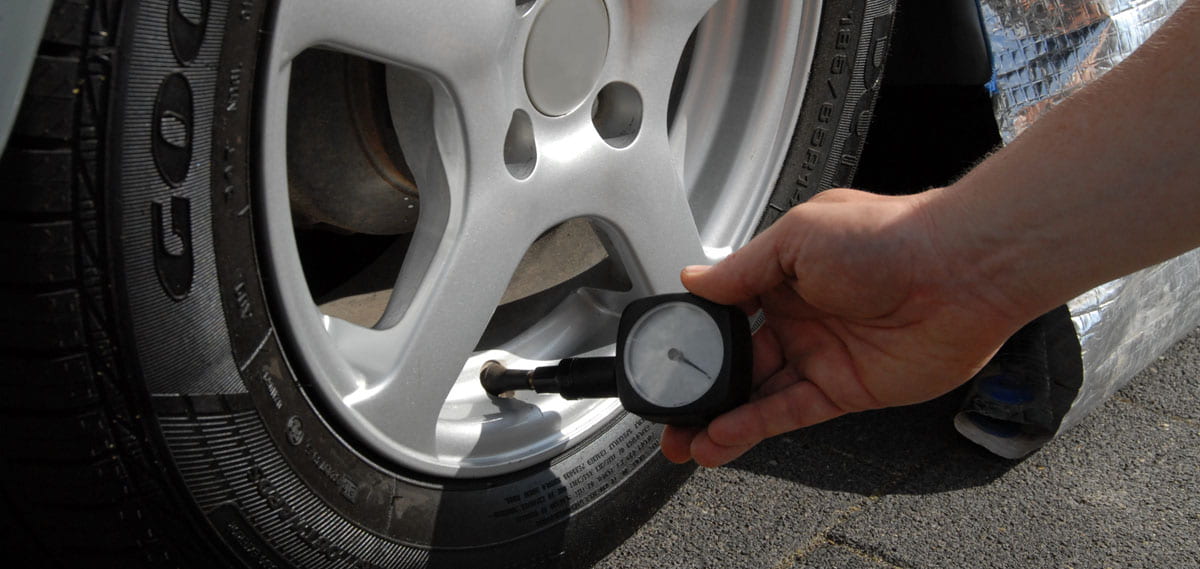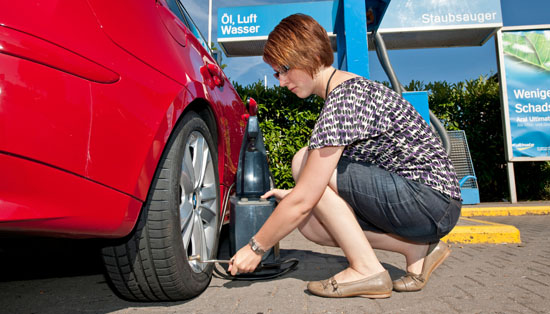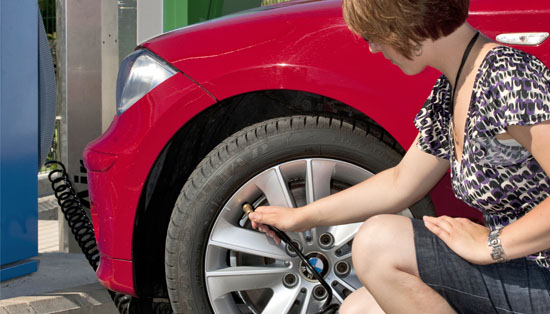Tyre Care and Maintenance Guide
The easiest way to help ensure satisfactory mileage and performance from your Goodyear tyres is to give them simple, monthly inspections for proper inflation, even tread wear, and damage.

Maintain proper inflation pressure in your tyres
Proper inflation pressure is necessary in giving you the best tire performance, safety, and fuel economy. Remember to frequently (at least once a month) check your tyres (when they are cool) with an accurate tyre pressure gauge.1
Maintain inflation pressure at the recommended level
The recommended level can be found on the vehicle placard or in your vehicle’s owner’s manual. Maintaining proper inflation pressure is the single most important thing you can do to help your tyres last longer and stay durable.
Under inflation is the leading cause of irrepairable tyre damage and may result in severe cracking and subsequent air loss. It reduces load capacity, allows excessive sidewall flexing, and increases rolling resistance, resulting in heat and mechanical damage.
Over inflation increases stiffness that may cause an uncomfortable driving experience and generate unwanted vehicle vibration. It also increases the chances of impact damage.
Don’t spin your tyres excessively
Avoid excessive tyre spinning when your vehicle is stuck in snow, ice, mud or sand. This may cause tyre over-heating and irrepairable damage. Use a gentle backward and forward rocking motion to free your vehicle. Never stand near or behind a tyre spinning at high speeds, for example, while attempting to push a vehicle that’s stuck or when an on-car spin balance machine is in use.
Check your tyres for wear
Always remove tyres from service when they reach 1.6mm remaining in tread depth. All new tyres have tread wear indicators that appears as smooth banks in the tread grooves when they wear to 1.6mm level. Wet weather accidents may occur from skidding on bald or nearly bald tyres. Excessively worn tyres are also more likely to suffer punctures.


Check your tyres for damage
Frequent (at least once a month) inspection of your tyres for signs of damage and their general condition is important for safety. If you have any questions, have your tyre dealer inspect them. Impacts, penetrations, cracks, knots, bulges, or air loss always require tyre removal and expert inspection.
Proper tyre repair
Note: Goodyear does not warrant any inspection or repair process. The repair is entirely the responsibility of the repairer and should be made in accordance with established Rubber Manufacturers Association (RMA)
procedures.
Tyre pressure monitoring system alert
Refer to your vehicle Owner’s Manual for more information on what to do if the tire pressure warning system activates.
Don’t attempt to mount your own tyres
Serious injury may result from explosion of tyre/rim assembly from improper mounting procedures. Remember to follow your tyre manufacturer’s instructions and match tyre diameter to rim diameter. Only specially trained persons should mount tyres.
Don’t mix tyre of different sizes and types on the same axle
For the best handling and control, Goodyear recommends fitting four tyres of the same type and size as specified by the vehicle manufacturer.
Warning
Before replacing your tyres, always consult the vehicle’s owner’s manual and follow the vehicle manufacturer’s replacement tyre recommendations. Vehicle handling may be significantly affected by a change in tyre size or type. When selecting tyres that are different from the original equipment size, see a professional installer to make sure that proper clearance, load-carrying capacity, and inflation pressure are selected. Never exceed the maximum load capacity and inflation pressure listed on the sidewall of the tyre. When replacing tyres, you must maintain the outside diameter and load-carrying capacity of the original equipment tyre. Inflation pressure may need to be adjusted to avoid overloading the tyre. Consult the Tyre & Rim Association Load and Inflation Tables, ETRTO or JATMA standards for correct load and inflation information.
Never fit tyres with less load-carrying capacity than required by the vehicle’s original equipment manufacturer
You must make certain that the replacement tyres have a load-carrying capacity equal to or great than what the original equipment manufacturer specifies.
NOTE: Goodyear manufactured and/or marketed European-Metric passenger tyres and P-Metric passenger tyres are interchangeable as long as they are the same section width, same aspect ratio and same rim diameter.
CAUTION: Never substitute a “Standard Load” (SL) tyre for an “Extra Load” (XL) tyre. If the vehicle was originally equipped with “Extra Load” (XL) tyres, replace those with same sized XL tyres.
Follow these additional guidelines
- When installing two tyres, fit the tyres with the deepest tread depth on the rear axle.
- If radials and non-radials must be fitted to the same vehicle, fit radials on the rear axle.
- Never mix radials and non-radials on the same axle.
- When fitting snow tyres or all-season tyres to performance vehicles, always fit in sets of four.
- It’s not recommended to fit tyres with different speed ratings.
- If tyres with different speed ratings are installed on a vehicle, they should be with like pairs on the same axle.
- The speed capability of the vehicle will become limited to that of the lowest speed rated tyres.
- When changing tyre sizes, always consult a dealer for optimum rim width and carefully check vehicle/tyre clearances.
Don’t overload your vehicle
Check your vehicle’s owner’s manual to determine the load limits. Overloading your vehicle places stress on your tyres and other critical vehicle components. This can also cause poor handling, increased fuel consumption and may cause tyre damage. Never fit your vehicle with new tyres that have less load capacity than shown on the vehicle tyre placard, and remember that optimum rim width is important for proper tyre load distribution and function.
Maintain vehicle suspension & wheel alignment, & balance & rotate your tyres
Lack of rotation, worn suspension parts, under inflation, over inflation, wheel imbalance, and misalignment can cause vibration or irregular tyre wear. Rotate your tyres according to your vehicle manufacturer’s recommendations or at maximum intervals of 6,000 mi./10,000 km.
For additional information, see the “Be Tyre Smart/Play Your Part” brochure published by the Rubber Manufacturers Association (RMA), a copy can be downloaded from the RMA website: http://www.rma.org/product/be-tire-smart-safety-brochure.
You can go to an authorised Goodyear outlet for replacement tyres and all warranty service.
How to read a tyre D.O.T. serial number
D.O.T. stands for Department of Transportation. This number is located on the lower sidewall of each tyre, showing that the tyre meets or exceeds the Department of Transportation safety standards.
Understanding Tyre D.O.T. serial numbers
12-digit number: 2000’s production
11-digit number: 1990’s production
M6MJEH0R0911
M6: Mfgr Plant Code
MJ: Government Size and Ply Code
EHOR: Manufacturer Construction Code
0911: Tyre Build Date (9th week of 2011)
Tyre Service Life
Tyres are built to provide thousands of mi./km of excellent service. For maximum benefit, tyres must be maintained properly to avoid tyre damage that may result in removal from service before the tread is worn down to minimum depth. It’s not practical to accurately predict the service life of any specific tyre in chronological time since service conditions vary widely.



